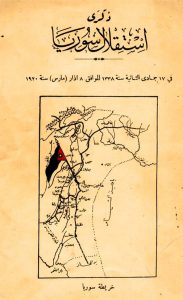The Destruction of Syria
The Destruction of Syria

Resources for Teaching
Part 1. The Invention of Syria
Syria, like most nations, is a modern invention. It was created in 1918 by the Syrian National Congress, who established a constitutional monarchy. The French invaded in 1920 and split the country into two, with the southern half under British rule.
Fictitious national assembly in “Lawrence of Arabia,” directed by David Lean, 1962 (IMDB entry).
Syrian national assembly and declaration of independence, 1918-1920 (Hathi Trust).
Ottoman provinces of the eastern Mediterranean (Levant, al-Sham, Greater Syria) (1893 map).
Ethno-sectarian groups (Gulf/2000, Columbia University).
Sykes-Picot Agreement, 1916 (Wikipedia).
French conquest of Syria, 1920 (map of French mandate).
Soundtrack: Malik Jandali, “Syrian Symphony,” 2014 (Soundcloud).
Further reading:
Al-Jazeera, “A Century On: Why Arabs Resent Sykes-Picot,” 2016 (Al-Jazeera).
Elizabeth Thompson, The Democratic Moment in Syria (Grove Atlantic, forthcoming).
Part 2. Independent Tyranny
When Syria gained independence in the 1940s, it had a parliamentary democracy. But a series of coups, beginning in 1949, led to ever more brutal dictatorships.
Nizar Qabbani, “Diary of an Arab Executioner” (poem), 1988 (Arabic recitation; English translation).
Further readings:
Lindsay Gifford, “The Change That Never Came,” Current History, December 2009, pp. 417-423.
Lisa Wedeen, Ambiguities of Domination, 2nd edition (University of Chicago Press, 2015).
miriam cooke, Dissident Syria: Making Oppositional Arts Official (Duke University Press, 2007).
Part 3: Four Revolutions
Beginning with a democratic uprising in March 2011, Syria has experienced four simultaneous revolutions, breaking the country into militarized mini-states. To regain power, the Syrian regime has bombed most of the major cities into rubble.
Soundtrack: Samih Choucair, “Ya Heif” (For Shame), 2011 (YouTube).
Vice News, “Bulldozing the Border,” August 13, 2014 (Vice News).
Map of conflict: NYMapper, “Syrian Civil War: Every Day,” 2018 (YouTube).
Further reading:
Charles Kurzman, “Syria’s Four Revolutions,” 2017 (Blog).
Additional resource:
miriam cooke, “The Historical Roots of the Syrian Crisis,” 2016 (Duke-UNC Consortium for Middle East Studies, “The Middle East Explained,” with teacher’s guide and student viewing guide).
Part 4: Shock Waves
The Syrian civil war drove a third of the population into exile. Five million sought refuge in neighboring countries – Jordan, Lebanon, and Turkey – and more than a million fled to Europe, generating shock waves that have upending the politics of Europe and the United States.
Soundtrack: Bu Kolthoum, “Terhaal” (Leaving), 2017 (Facebook).
Syrian refugee statistics (The Refugee Project).
Zaatari refugee camp, Jordan (BBC).
Donald Trump reciting “The Snake,” 2016-2018 (Charles Kurzman).
Syrian refugee family, 2014 (Time).
Further reading:
Charles Kurzman,”The Man Who Broke the World,” 2018 (Blog).
Refugee assistance organizations:
United Nations Refugee Agency (UNHCR).
U.S. Department of State, Bureau of Population, Refugees, and Migration (Refugee Admissions).
U.S. Committee for Refugees and Immigrations (offices in North Carolina and around the United States).